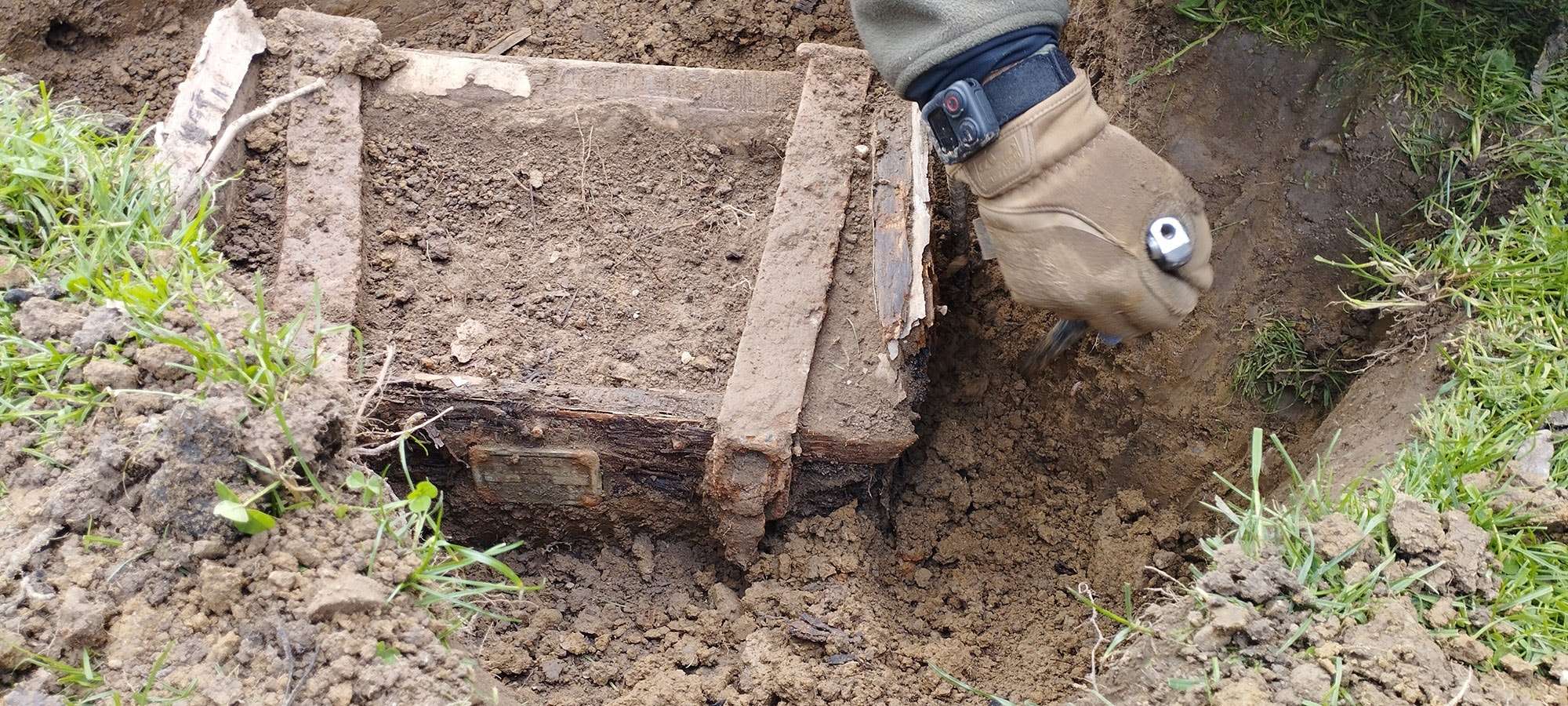For nearly 80 years, it was just a story—an improbable tale whispered among the families of vanished soldiers and tucked into the margins of military memoirs.
It told of US General George S. Patton, the hard-charging American icon, quietly allowing an elite Hungarian cavalry unit that had fought alongside the Nazis to surrender safely to US forces, sparing them from the brutal fate that awaited them under Stalin.
But that legend may soon be rewritten as fact—thanks to a mud-caked chest buried under a deer enclosure in an Austrian zoo, and the tireless work of one man determined to find it.

Picture shows researcher Pajkos Zoltán (left) and military historian Szebenyi István (right). Note: Licensed photo.(Szebenyi Istvan/RealPress)
Istvan Szebenyi, 56, a Hungarian military historian. had searched for the chest for years and tracked down fragments of the Royal 1st Honved Hussar Division, a storied cavalry unit swallowed by the chaos of 1945.
Then came the letter. The historian said: "Two years ago, the daughter of one of the division's tragically fated senior officers showed me a letter in which the division's clerk mentioned that documents were buried in the ground at an Austrian castle. At that time, I did not yet know which castle it was.”
What followed was a scholar’s odyssey: a cold trail, endless research, and a journey to a 40-hectare zoo called Tierpark Haag, which now covers the grounds of Salaberg Castle in Lower Austria.

Picture shows the chest unearthed at Salaberg Castle. Note: Licensed photo.(Szebenyi Istvan/RealPress)
Szebenyi said: "When I travelled to the site, I saw only a 1 per cent chance that the chest could be found."
He added: "But in the end, we didn’t give up the search, and luck was on our side."
Beneath the hooves of deer, under soil untouched since the war, Szebenyi, using a metal detector, found the battered wooden chest, apparently packed with wartime documents from the 1st Honved Hussars, "in remarkably good condition" after 80 years.
And within those pages, perhaps, lies proof of one of the war’s strangest moral dilemmas.

Picture shows the chest unearthed at Salaberg Castle. Note: Licensed photo.(Szebenyi Istvan/RealPress)
One of the legends surrounding the division is that they escaped Soviet capture in May 1945 thanks to the help of US General George S. Patton—a story long dismissed as myth.
To understand why the chest matters, one must return to May 1945. Germany was crumbling. The Red Army was storming across Central Europe. And Hungary’s army—once a proud Axis ally—was disintegrating.
The Royal 1st Honved Hussar Division faced capture by the Soviets near Salaberg Castle, but then, according to memoirs and oral histories, came a lifeline: General Patton.

Picture shows the chest unearthed at Salaberg Castle. Note: Licensed photo.(Szebenyi Istvan/RealPress)
The American general, a cavalryman to his bones – he had competed in the 1912 Stockholm Olympics in the modern pentathlon – is said to have intervened personally.
The hussars claimed Patton allowed them to surrender to the Americans, granting them protection from Soviet capture.
Szebenyi said: “The hussars frequently mention in their recollections that they owe their passage to the western zone to General Patton."

Picture shows Salaberg Castle, Austria. Note: Licensed photo.(Szebenyi Istvan/RealPress)
It is believed that Patton may have been friends with a Hungarian Colonel called Malanotti from the Hussar division, a friendship that is said to have predated the war.
Szebenyi continued: "Thanks to this friendship, the hussars received Patton's benevolent assistance, allowing them to avoid Russian captivity—many owed their lives to this act.”
Asked what he believes happened to the division at the end of the war, Szebenyi said: “On 8th May 1945, the hussar division disappeared from the stage of history forever.
"However, they owed their survival to the American General Patton. The Americans treated the hussars in captivity with great kindness and friendship, as many of them recalled in their memoirs.”

Picture shows Salaberg Castle, Austria. Note: Licensed photo.(Szebenyi Istvan/RealPress)
He added: "The friendship between Patton and Colonel Malanotti is mentioned in the hussars' recollections when they describe what happened on 8th May 1945. When Patton arrived at the castle, he specifically asked for Colonel Malanotti by name.
"However, the colonel had already retired by then. Patton only found this out when he was informed upon arrival. But it was their previous sports friendship that led him to save the hussars.
"The chest is believed to contain the documents referenced in the letter by the person who hid them—Bano-Kacskovics Zoltan."
Szebenyi continued: "When Patton arrived at the castle, he specifically asked for Colonel Malanotti by name.
"However, the colonel had already retired by then. Patton only found this out when he was informed upon arrival. But it was their previous sports friendship that led him to save the hussars."
Szebenyi believes the chest may offer clues—orders, diaries, communications—that could confirm what really happened that day in 1945.

Picture shows the team from the dig. Note: Licensed photo.(Szebenyi Istvan/RealPress)
For Szebenyi, the discovery is a career-defining moment.
He said: “It's a fantastic feeling—I can hardly believe it even now! Since then, I've received countless inquiries, and many people have written to me.
"Once again, I’m being approached with legends describing hidden documents and equipment buried in Austria. They are asking me to find them and bring them home. On social media, they call me the Hungarian ‘Indiana Jones,’ which is incredibly flattering.”
Szebenyi added: “I strive to prioritise the stories and begin research on these cases accordingly. I want to bring everything back to Hungary that can be found!
"These historical relics belong in Hungarian museums. Unfortunately, 50 years of communist dictatorship completely destroyed our artefacts and documents from this era.”
After the discovery, Lukas Michlmayr, the mayor of Haag, said: "The discovery was made by Hungarian military historian Istvan Szebenyi almost exactly 80 years after the end of the war and confirms a long-standing legend.
“The box contained diaries, orders and situation reports from the last days of the war, when around 10,000 Hungarian soldiers were stationed in the vicinity of the castle.
“Thanks to the friendship between Hungarian Colonel Malanotti and US General Patton, the division was allowed to surrender to the Americans in May 1945 via the power plant in Ernsthofen – thus escaping Soviet captivity."
Szebenyi said that the chest is set to be opened and fully assessed in Vienna on Monday.
(Joseph Golder / newsX)


